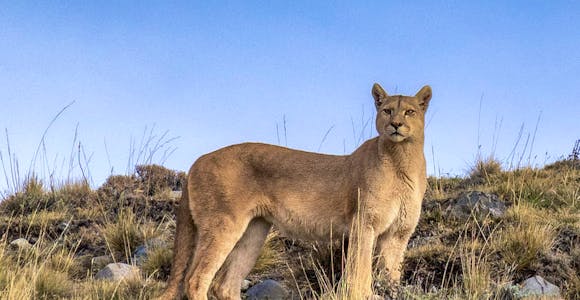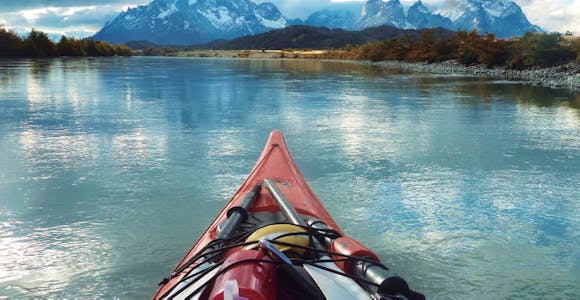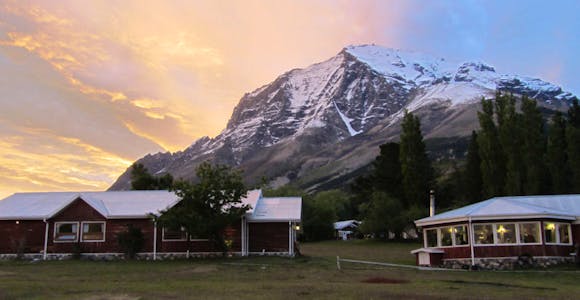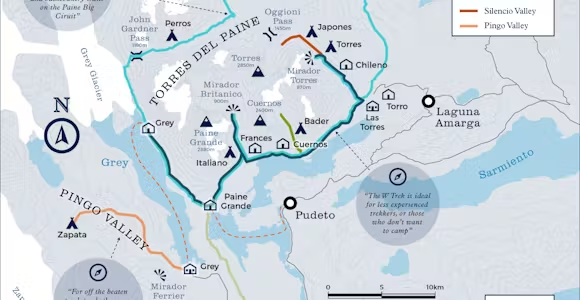
Wildlife in Torres del Paine
Torres del Paine’s mountains and plains offer a spectacular backdrop for incredible wildlife encounters, from puma tracking to watching condors soaring on the thermals.
Discover MoreDeep roots in Patagonia: We are ex-guides, tour leaders, outdoor enthusiasts, & adventurers.
We’ve got our feet on the ground: Impartial advice, a bespoke service, and at no extra cost.
For the ends of the Earth: Sustainability is more than our carbon footprint (but we’re reducing that too).

With a keen eye, a soft approach and a little bit of luck, you can encounter a wealth of birds and mammals in Torres del Paine, most whilst you're out and about exploring the park. If you really want to focus on the wildlife, dedicated wildlife guides will be able to take you to secret spots which hide rarer animals away from the main trails.
The least camera-shy of all animals in Torres del Paine, look out to the horizon and you're more than likely to find a guanaco grazing somewhere. And if you've seen one, more won't be far away, these sociable animals only hang around in large groups.
Guanacos are the largest indigenous herbivore of the Patagonian steppe, and family herds cover between 250 and 1250 acres. You'll find them foraging for bushgrass, shrubs, lichens, fungi and herbs during the day, ears pricked to listen out for pumas, their main predator. They can survive without drinking for long periods, getting most of their water from grazing.

Guanacos in Torres del Paine
Hairy armadillos are nocturnal in summer, and in winter only emerge in the daytime if they're not hibernating. If you are lucky enough to see one, you'll note powerful legs and long hair between the plates of their shell. Living mostly in deep complex tunnels, their eyesight is poor but they can run surprisingly fast. They are often hunted as a pest, but in areas where they are unmolested they can become tame, boldly wandering around ranch houses and grounds, especially if there's food available.
Pichi (dwarf) armadillos are solitary and shy, but in contrast to hairy armadillos they are active during the day. Their shells are characteristically rounded, covered in small rectangular scutes of black and cream. They dig shallow burrows to forage, and deeper burrows, up to 1.6m below the surface, to take refuge. They are sometimes kept as house pets but are also hunted for their meat and shell.

Patagonian hog-nosed skunks are mainly active at night, although you may see them foraging during the day, especially in the evenings. They dig their burrows in drier desert areas, and forage for insects, grubs, vegetable matter and small vertebrates. They excavate deep burrows with long claws, and in winter, they close the entrance and live off stored food.
Like other skunks, they have a pungent scent which they will spray from glands when startled. However, for the most part, they are tame and confident animals.

A slight, grey body and curious nature mark out these foxes, which roam around the drier steppe areas of the region. They are diurnal and fairly bold, so you're not unlikely to see them out searching for birds, rodents, insects and berries. Listen out for their sharp yap as they call.
Despite being a protected species in Chile, illegal hunting still occurs by farmers fearful for their livestock.

The word culpeo is said to derive from the Mapuche culpem, meaning madness, which hinted at the bold way in which this red fox revealed itself to hunters. Nowadays it's a little more inconspicuous, hiding in caves and under vegetation during the day, or digging deep dens when breeding.
They are audacious hunters - sheep make up 20% of their diet, the rest comprising of rodents, birds, eggs and berries. They are protected in Chile but still sadly hunted for their pelts.

Slender cats with long, thin tails, looking not unlike a house cat. Geoffroy's cats vary widely in colour, from a silver-grey to all black, though they are generally identifiable by their large black spots. They were originally named after Geoffroy St Hilaire, a naturalist from the early 1800s.
Mostly nocturnal, they come out at night to hunt birds and small rodents, and can swim very well if forced.

Rheas are exclusive to South America. Characterised by open-vaned feathers, their plumes are billowing and useless for flight, though that's not a problem in escaping predators as their legs are incredibly strong and fast.
During the day they feed on berries, leaves, grass and seeds as well as insects, sticking together in flocks of up to 50 birds. Molting occurs between September and March, and breeding starts in the Patagonian winter around July. Females can lay 40 eggs in one nest, before moving on to another mate while the males incubate and rear the chicks. Look out for them foraging, preening and dust-bathing in the more arid areas of the national park.

Spot a Lesser Rhea roaming the steppe
A large endangered woodpecker with a spectacular splash of red complementing their blue-black body. Males have scarlet heads, females red feathers at the base of their bill. They also have a noticeable white V on their backs and a conspicuous white underwing patch. You may hear them before you see them, listen out for a loud two-tone hammer as they search for food.

Magellanic Woodpecker
As the name suggests, these swans have a long black neck which contrasts with their white body. Found on lakes and open water, they stick together in flocks of 5 - 20 birds, feeding on aquatic plants and building bulky nests on the shore.

Found in small flocks in forests and open woodland, where it forages for seeds, fruit, berries and buds, also foraging on the ground on dandelions, grass seeds, roots and bulbous plants. The Austral parakeet is identifiable by the metallic-blue sheen on its wings and red patch on its abdomen.


Torres del Paine’s mountains and plains offer a spectacular backdrop for incredible wildlife encounters, from puma tracking to watching condors soaring on the thermals.
Discover More
Torres del Paine has a host of activities on offer, from classic hikes to tracking pumas. Explore on horseback, mountain bike or even paddle your way to a glacier.
Discover More
Torres del Paine National Park has a wide selection of hotels, dotted in and around the park and varying in size, standard, location and budget.
Discover More
Maps of Torres del Paine National Park. Find the key routes and landmarks, and choose the best maps for trekking.
Discover MorePatagonia is a vast and varied region, with a wealth of things to see and do, a range of places to stay and a limited transport network.
Tap into 400,000 hours of lived experience. As guides, guardians and travellers, we know these incredible places intimately and care about them deeply. From a world of options, we'll help you discover your perfect adventure.
We'll spend some time listening to your aspirations, then discuss the kind of experience that might suit you.
Next we'll discuss the options, shortlist the best trips for you and present you our impartial recommendations.
We'll place a 24 hour hold on your preferred option - without obligation - whilst we talk through the details.
Get in touch today to talk about your dreams for your trip. Whether it’s a 2-week or 2-month adventure, you’re travelling independently or in a big group, you want to see Patagonia in comfort or discover challenging hikes, we’d love to help.
1 888 970 4571This website uses cookies to ensure you get the best experience on our website. Privacy policy